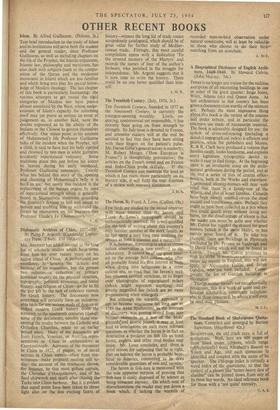The Heron. By Frank A. Lowe. (Collins. 18s.)
FEW birds are studied by the casual observer with more interest than the. heron, and Frank A. Lowe's monograph should be enthusiastically received. He is well qualified for the task of writing about this country's only familiar member of the stork family, as he has spent a very long time studying the species as both a scientist and a naturalist.
It is, however, depressing to what an extent nature observation is now confined to the laboratory. It cannot bes.pf any great inter- est to the average lield-studaiste_meee after all probably found his first interest in birds when diving into hedgerows in a more callous era, to read that the heron's neck has nineteen cervical vertebrae, or to linger over photographs of regurgitated pellets (which might represent anything) and greatly magnified lice (which are no more prepossessing when enlarged).
But although the scientific approach is apt to become wearisome (as long ago as 1789 the Abbe Spallanzani, in the interests of discovery, was putting tinned frogs into herons'--stomachs as a jest of the birds' gizzardsland gastric juices), it may at least lead to conclusions on such more relevant questions as whether the heron is in fact so destructive a predator on fish life as trout farms, anglers, and other rival bodies may insist. Mr. Lowe concludes, and there is good reason for supposing that he is right, that on balance the heron is probably bene- ficial to fisheries, consuming as he does considerable quantities of eels and vermin. The heron in folk-lore is mentioned with the sole apparent purpose of proving that
—Mlle-lore is easily disposed of by science as being nonsense anyway. On which note of disenchantment the reader may put down a book which, if lacking the warmth of
recorded man-to-bird observation under natural conditions, will at least be valuable to those who choose to do their birele- watching from an armchair.


































 Previous page
Previous page